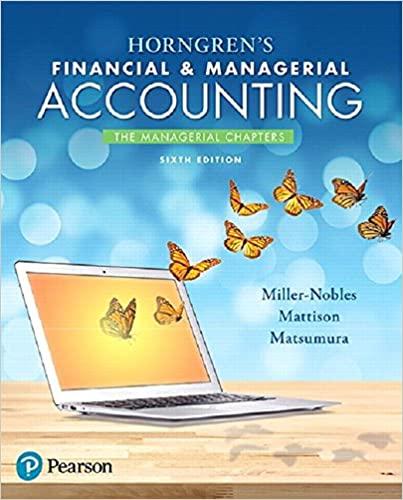Question
Case Study 1 Performance Evaluation and Decentralization This assignment relates to the following Course Learning Requirements: CLR 2:Apply theconceptsofrelevantcosting togenerateoperationalrecommendationstomanagement. CLR 4:Evaluateandapplytheoriesofperformancemeasurementtorewardemployee performance. CLR 5:Identify
Case Study 1 Performance Evaluation and Decentralization
This assignment relates to the following Course Learning Requirements:
CLR 2:Apply theconceptsofrelevantcosting togenerateoperationalrecommendationstomanagement.
CLR 4:Evaluateandapplytheoriesofperformancemeasurementtorewardemployee performance.
CLR 5:Identify and apply social responsibility practices that contribute to local and global communities.
Objective of this Assignment:
Demonstrate your learning of the chapter material, and the ability to explain various concepts.
Pre-Assignment Instructions:
- To prepare for this assignment, read modules 5 to 7 content and follow the embedded learning activities.
- Read Chapter 12 of the Textbook.
- Complete Modules 5 to 7 Learning Activities.
Assignment Tasks:
- Based on the excerpts above, compare and contrast the strategies of Applied Pharmaceuticals and Destination Resorts International.
2. Select balance scorecard measures for each company and link the scorecard measures using the framework from Exhibit 12-6. Use arrows to show the causal links between the performance measure and show whether the performance measure should increase or decrease over time. Feel free to create measures that may not be specifically mentioned in the chapter, but make sense given the strategic goals of each company.
3. What hypotheses are built into each balanced scorecard? Why do the hypotheses differ between the two companies?
4. Based on what we have learned about Triple Bottom Line (TBL) in Module 6 on Brightspace, how could both companies incorporate TBL into their balanced scorecard?
Question 1
Creating Balanced Scorecards That Support Different Strategies
The Performance Enhancement Group (PEG) helps companies to build balanced scorecards. As part of its marketing efforts, (PEG) conducts an annual balanced scorecard workshop for prospective clients. You are PEG's newest employee, so your boss has asked you to participate in this year's workshop by explaining to attendees how a company's strategy determines the measures that are appropriate for its balanced scorecard. Your boss has provided you with the excerpts below from the annual reports of two current PEG clients. She has asked you to use these excerpts in your portion of the workshop.
Excerpt from Applied Pharmaceutical's annual report.
The keys to our business are consistent and timely new-product introductions and manufacturing process integrity. The new-product introduction side of the equation is a function of research and development (R&D) yield (e.g., the number of marketable drug compounds created relative to the total number of potential compounds pursued). We seek to optimize our R &D yield and first-to-market capability by investing in state-of-the-art technology, hiring the highest possible percentage of the "best and the brightest" engineers, and providing world-class training to those engineers. Manufacturing process integrity is all about establishing world-class specifications and then relentlessly engaging in prevention and appraisal activities to minimize defect rates. Our customers must have an awareness of and respect for our brand image of being "first to market and first in quality". If we deliver on this pledge to our customers, then our financial goal of increasing our return on shareholder's equity should take care of itself.
Excerpt from Destination Resorts International's annual report:
Our business succeeds or fails based on the quality of the service that our front-line employees provide to customers. Therefore, we must strive to maintain high employee morale and minimize employee turnover. In addition, we must train our employees to use technology to create one seamless worldwide experience for our repeat customers. Once an employee enters a customer preference (e.g., provide two extra pillows in the room, deliver freshly brewed coffee to the room at 8:00 AM. etc.) into our database, our worldwide workforce strives to ensure that a customer will never need to repeat this preference at any of our destination resorts. If we properly train and retain a motivated workforce, we should see continuous improvement in our percentage of error-free repeat customer check-ins, the time taken to resolve customer complaints and our independently assessed room cleanliness.This in turn should drive improvement in our customer retention, which is the key to meeting our growth goals.
Required:
1. Based on the excerpts above, compare and contrast the strategies of Applied Pharmaceuticals and Destination Resorts International.
2. Select balance scorecard measures for each company and link the scorecard measures using the framework from Exhibit 12-6. Use arrows to show the causal links between the performance measure and show whether the performance measure should increase or decrease over time. Feel free to create measures that may not be specifically mentioned in the chapter, but nonetheless make sense given the strategic goals of each company.
3. What hypotheses are built into each balanced scorecard? Why do the hypotheses differ between the two companies?
4. Based on what we have learned about Triple Bottom Line (TBL) in Module 6 on Brightspace, how could both companies incorporate TBL into their balanced scorecard?
Step by Step Solution
There are 3 Steps involved in it
Step: 1

Get Instant Access to Expert-Tailored Solutions
See step-by-step solutions with expert insights and AI powered tools for academic success
Step: 2

Step: 3

Ace Your Homework with AI
Get the answers you need in no time with our AI-driven, step-by-step assistance
Get Started


